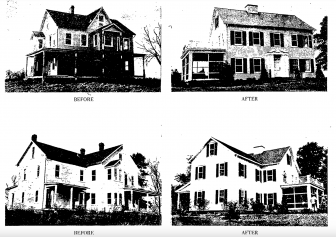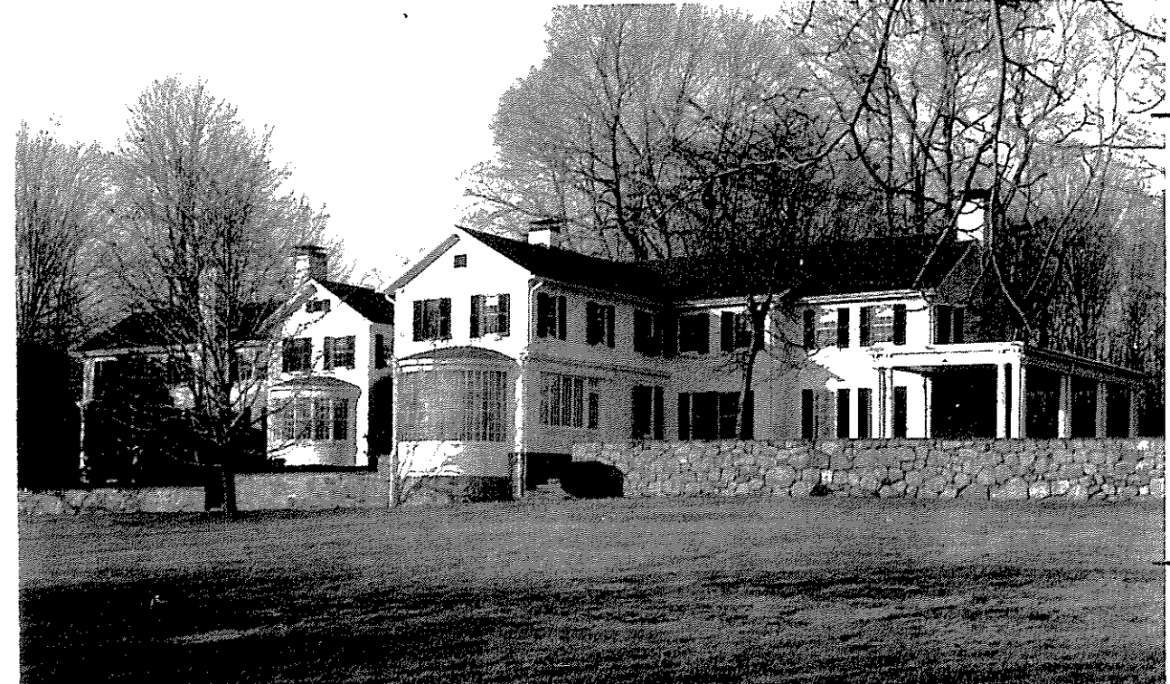‘Now & Then’ is sponsored by Brown Harris Stevens Realtors Joanne Santulli, Karen Ceraso, Bettina Hegel and Schuyler Morris.
The property known as “Lone Tree Farm,” consisting of 45 acres, was purchased from Eliphalet and Sarah St. John in 1830 by Charlotte and Hiram Brown.
The St. Johns made their residence farther north on Canoe Hill Road near Ferris Hill and when the property was sold to the Browns the deed indicated the only building on the property was a barn. It is assumed that the Browns built the original home measured 18-by-14-feet. Its unusual exterior construction consists of ¾-inch-thick wooden blocks that are faced to look like stone. The distinctive sheathing matches the style used on the Washington mansion at Mount Vernon, Va. There are references to the home being known as “The Old Block House” but it is unclear whether this reference was because of its unusual construction.
The Browns owned the property until 1871 when it was sold to Gilbert Birdsall. Mr. Birdsall was the superintendent of the Third Avenue Street Railway Company. (For more information on Mr. Birdsall see New Canaanite Now & Then dated June 9, 2022.) Gilbert Birdsall died in 1886. The estate was sold by his widow Ann E. Birdsall in 1906 to A. Victor Barnes.
Colonel Barnes, a Yale graduate, was the heir to the American Book Company fortune as well as a financier and investment entrepreneur. He was a lieutenant colonel in World War I and served in the Ordnance Department of the U.S. Army. When he purchased the property “for a song” according to a New Canaan Advertiser article dated Nov. 2, 1916 he believed he was buying a stone house. It was reported that the house was a “tumbledown disreputable structure which could neither be rented or sold.”

Lone Tree Farm. Images courtesy of the New Canaan Museum & Historical Society
Colonel Barnes hired Justice F.S. Dawless to renovate and expand the home, making it three times its original size. Barnes used wood grooves to resemble stone on the additions. At the time of the purchase the property was 45 acres but Colonel Barnes purchased adjacent property from the B. Fischer Estate to pursue his interest in dairy farming. Colonel Barnes started breeding his own Jersey cattle and became a gentleman farmer. Barnes may have been instrumental in persuading the National Dairy Show to hold its competition in the East in 1916 rather than the West where his cattle received three of six prizes. Colonel Barnes went on to serve as the president of the American Cattle Club and the dairy farm continued until the beginning of World War II. As a side note, Justice Dawless and W.S. Lockwood argued in February 1909 to implore the Board of Warden and Burgesses to establish a building line preventing construction too close to the sidewalk and to straighten and widen East Avenue.
The property was named “Lone Tree Farm” because of the single outstanding tree on the hilltop property which was one of the highest in the community. The “Lone Tree” has given its name to a road off of Brushy Ridge that was established in 1952. In a 1967 article for the New Canaan Historical Society Annual, the tree reportedly served as a beacon for sea captains when navigating the Long Island Sound because it could be seen so vividly in the horizon. That same article reports that “treasures” were hidden from British troops during the 1779 Battle of Norwalk and were being unearthed for many years. The Lone Tree is also featured in the Walter Bradnee Kirby WPA “aerial” painting in Town Hall (lower left side).
The home at Lone Tree Farm was expanded to include 26 rooms. The old house served as the entrance hall. According to Colonel Barnes’s son, it was important to his father that the original structure remain intact. The home included a basement laundry room and drying room and a library that held 1,500 books including first editions. In the 1930s, Colonel Barnes found papers indicating (in his opinion) that the original house had been constructed closer to 1815 but his claim could not be substantiated.
The Barnes were active in the community, with Ms. Barnes serving on the Visiting Nurses Association Committee, participating in the 1952 Garden House Tour, Chairman of the Thrift Shop volunteers and in October 1940 hosting a meeting with the chair of the Connecticut Committee to Make Birth Control Legal (Ms. Barnes served as the New Canaan Chairman of the Stamford Committee). Ms. Barnes also served as vice-chairman for the War Fund Appeal of the Red Cross in 1945. Colonel Barnes died in November 1944. In 1953 Ms. Barnes, who served as the chairman of the administrative board for the Community Mental Hygiene Clinic, held a country carnival on her estate to benefit the cause. The organization became the Silver Hill Foundation and the carnival was held on the estate for a few years. Ms. Barnes died in 1978.
In 1980 their son, A. Victor Barnes, Jr. listed the home for $525,000. In the mid 1960s the property had been subdivided and sold off, leaving the Barnes estate with four of its former 106 acres. Mr. Barnes Jr. and his wife, Yvonne were building a new home in Florida at that time. Ms. Barnes was the owner of the New York dress manufacturing company, Yvonne Dazay, Ltd. In 1981 Mr. Peter K. Underhill purchased the property.

